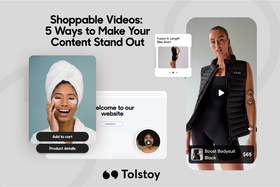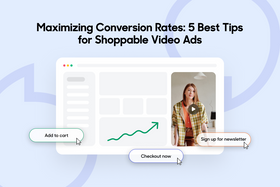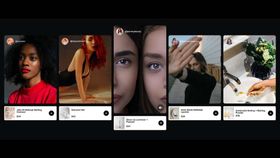Measuring the Effectiveness of Shoppable Videos: Sales and ROI
Published April 30, 2023.

It's true that so many e-commerce video marketers are limited by what they can "measure." Although views, likes, and shares are important metrics to consider for social video content, sales truly matter in the long term.
With the rise of shoppable videos, marketers can now track viewership and how viewers interact with their product within the video—whether they click through to purchase or watch it passively. But first, let's define what return on investment means.
Return on Investment (ROI)
Return on investment is a way to measure how well an investment (or portfolio of investments) has done financially. It is calculated by dividing the gain or loss from an investment (or portfolio of investments) by the amount that was invested at the start.
The result is usually given as a percentage, and people often use it to compare investments and decide how to invest in the future. The better investment is thought to be, the higher the return on investment.
» Need help? See how to make your shoppable videos stand out
How to Measure Sales and ROI
- Engagement rate Track the total number of views and average engagement time for each shoppable video. This will help you understand if customers are finding your videos helpful or if they’re watching them all the way through.
- Click-through rate Monitor the number of clicks per video, which measures how often customers are clicking to purchase items after viewing the video.
- Conversion rate Figure out how many people bought something after watching a shoppable video, probably the most important metric to track for shoppable video performance.
- Average order value Calculate the average amount of money spent per transaction.
- Return on investment (ROI) Analyze the performance of each campaign and compare it to the campaign's total cost to determine if you’re getting a positive return on your investment.
» Learn more: Our best examples for short shoppable video ads
Use the Right Tools
- Tolstoy After creating your shoppable videos with Tolstoy, you can make use of our built-in analytics software to see how effective your marketing efforts are. Simply read our guide to tracking Tolstoy analytics.
- Google Analytics First, you will need to set up tracking for your shoppable videos in Google Analytics. This includes adding tracking codes and event tags to your video player so that data is collected and stored, measuring all the metrics discussed above. You can also look at how different videos compare against each other and adjust your strategy accordingly.
- Adobe Analytics Adobe analytics is a great program for measuring the effectiveness of all your marketing efforts, from basic web statistics to all your digital channels.
- KISSmetrics KISSmetrics is an easy-to-use analytics platform that helps you measure the performance of your marketing tactics through various means and metrics, including your sales funnels, and integrates seamlessly with your Shopify store.
» Ready to get started? Create your first shoppable video for free
What Other Metrics Should You Track?
1. CTR (Click-Through Rate)
CTR measures how often people click on the CTAs (calls-to-action) on your video, such as clickable buttons. Tracking CTR trends can also help you anticipate how changes in your video content will affect future sales, making it easier to adjust and optimize your strategy as needed. Knowing what your viewers are responding to is key to creating a successful sales campaign, and tracking CTR trends can give you insight into this.
Dwell Time and Click-Out
Shoppable videos give valuable information about people's actions by tracking how long they look at a certain object or screen. This metric is especially helpful for figuring out how well different products and services grab the attention of customers.
For example, if you’re offering different types of videos, you can measure which type has the highest dwell time and click-out rate, giving you insight into your products with the highest conversion potential.
Interactions/Engagement
Engagement is a metric used to measure how much viewers interact with your video, how many people watched from start to finish, whether they shared or liked the video, and even exactly when people stopped watching.
KISSmetrics is a great tool for measuring engagement because it allows you to track the amount of time users spend viewing your videos, as well as how often they click out, how many times they share, and which parts of the video were most popular. This can help you identify any potential problems in how your video was presented or structured, and adjust accordingly for maximum engagement.
» See how videos can improve customer experience
Video views
Another important metric to consider tracking is video views. This metric can tell you how many people have seen your shoppable videos, regardless of whether they interacted with them. The more people that have seen the video, the better off your ROI is likely to be.
Video views give you a good indication of the success of your video content. It's important to note, however, that simply having a high number of views does not guarantee sales due to how different platforms measure video views. For example, YouTube only counts a view when somebody intentionally watches your video for 30 seconds, while Facebook and Instagram count it after just 3 seconds.
» Use Shopify for your e-commerce store? Discover how to embed shoppable videos on Shopify
Can You Boost Specific Metrics?
If you want to boost a specific metric, such as CTR or dwell time, you can use data analytics and testing to determine the effectiveness of different strategies. Following that, there are many things you can do to boost specific metrics. For example:
- Interesting thumbnails can grab attention and make people click more.
- Captions can make people watch for longer if they can't listen.
- Different video formats for different platforms, such as landscape for YouTube or portrait for Instagram.
- Keeping your CTAs and/or products on screen for longer can improve dwell time.
» Learn more: Our tips for shoppable videos on mobile

























